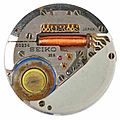Quartz crisis facts for kids
The Quartz crisis was a huge change in the world of watchmaking. It happened in the 1970s and early 1980s. This "crisis" was caused by the invention of quartz watches. These new watches used a tiny vibrating crystal to keep time.
Quartz watches quickly became very popular. They were much cheaper to make than older mechanical watches. They were also more accurate, meaning they kept time better. Because of this, quartz watches started to replace mechanical watches all over the world.
This was a big problem for Swiss watchmakers. Switzerland was famous for making high-quality mechanical watches. Many Swiss companies struggled because people wanted the new, cheaper, and more accurate quartz watches instead.
Most of the first quartz watches came from Japan. Companies like Seiko, Citizen, and Casio were leaders in this new electronic watch technology. They were the first to bring these new watches to the market.
Contents
What is a Quartz Watch?
A quartz watch is a type of electronic watch. It uses a small piece of quartz crystal to keep time. When electricity passes through the quartz, it vibrates at a very steady rate. This steady vibration helps the watch count time very accurately.
How it Works Simply
Imagine a tiny, super-fast pendulum inside the watch. But instead of swinging, it vibrates. This vibration is incredibly precise. It helps the watch tell the exact time.
The Rise of Quartz Watches
Before the 1970s, most watches were mechanical. They had tiny gears and springs that moved together. These watches were often expensive and needed careful making.
Japan's Innovation
Japanese companies saw a chance to make watches differently. They invested in new electronic technology. In 1969, Seiko released the first quartz wristwatch, the Seiko Astron. This was a big step!
Why Quartz Was Better
Quartz watches had several advantages:
- Accuracy: They kept time much more precisely than mechanical watches.
- Cost: They were cheaper to produce, making them affordable for more people.
- Durability: They often had fewer moving parts, making them tougher.
Impact on Swiss Watchmaking
Switzerland had been the world leader in watches for centuries. Their watchmakers were experts in crafting complex mechanical movements.
A Difficult Time
When quartz watches became popular, Swiss companies faced a tough challenge. Many people stopped buying their expensive mechanical watches. This led to job losses and factory closures in Switzerland.
Swiss Response and Recovery
Swiss watchmakers had to adapt. They started making their own quartz watches. They also focused on high-end, luxury mechanical watches. These watches became seen as art or special items.
One important step was the creation of the Swatch watch in the 1980s. Swatch made fun, colorful, and affordable quartz watches. This helped the Swiss watch industry recover and find new success.
Images for kids
-
The first Swiss quartz clock, which was made after World War II (left), on display at the International Museum of Horology in La Chaux-de-Fonds
See also
 In Spanish: Crisis del cuarzo para niños
In Spanish: Crisis del cuarzo para niños





